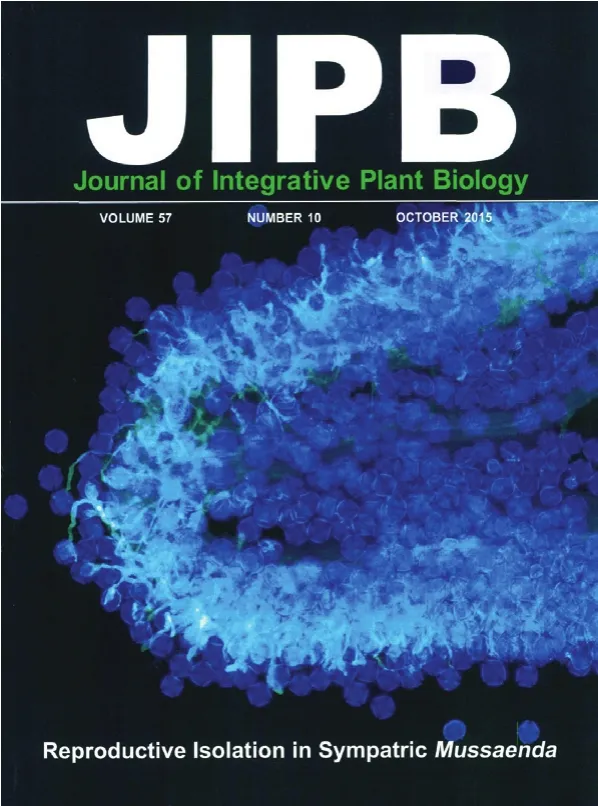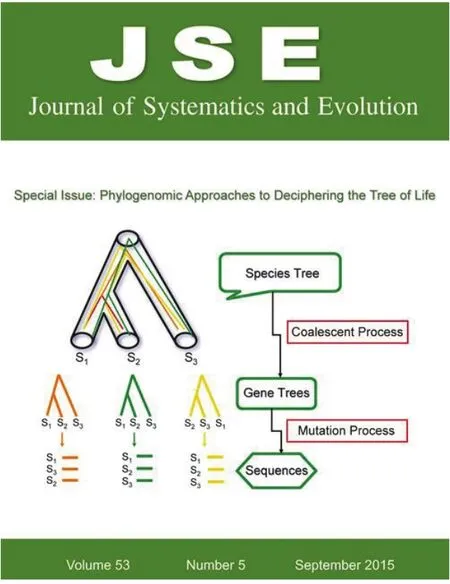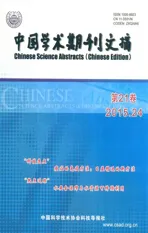植物学
2015-02-28
植物学

来源出版物:Journal of Integrative Plant Biology, 2015, 57(10): 859-870联系邮箱:ZHANG Dianxiang, dx-zhang@scbg.ac.cn

封面介绍:The hierarchical model for multigene sequence data. The model consists of three components-alignments, gene trees and the species tree. This hierarchical model involves two layers; the sequences-and-genetree layer and the genetree-and-speciestree layer. The model assumes that the gene trees are generated from a coalescent process occurring along the lineages of the species tree, while the sequences are generated from a mutation process occurring on the branches of the gene trees.
Coalescent methods for estimating species trees from phylogenomic data
LIU Liang, WU Shaoyuan, YU Lili
Abstract:Genome-scale sequence data have become increasingly available in the phylogenetic studies for understanding the evolutionary histories of species. However, it is challenging to develop probabilistic models to account for heterogeneity of phylogenomic data. The multispecies coalescent model describes gene trees as independent random variables generated from a coalescence process occurring along the lineages of the species tree. Since the multispecies coalescent model allows gene trees to vary across genes, coalescent-based methods have been popularly used to account for heterogeneous gene trees in phylogenomic data analysis. In this paper, we summarize and evaluate the performance of coalescent-based methods for estimating species trees from genome-scale sequence data. We investigate the effects of deep coalescence and mutation on the performance of species tree estimation methods. We found that the coalescent-based methods perform well in estimating species trees for a large number of genes, regardless of the degree of deep coalescence and mutation. The performance of the coalescent methods is negatively correlated with the lengths of internal branches of the species tree.
Keywords:coalescent methods; incomplete lineage sorting; phylogenomic data; species tree
来源出版物:Journal of Systematics and Evolution, 2015, 53(5): 380-390联系邮箱:LIU Liang, lliu@uga.edu
封面介绍:Reproductive Isolation in SympatricMussaendaReproductive isolation may lead to formation of new species. In this issue, Luo et al. (pp. 859-870) report that principal pollinators between two sympatric sister species ofMussaendadiffered strikingly, and interspecific pollination resulted in significantly reduced pollen tube growth rates. These findings strongly suggest that pre-zygotic isolation plays an important role in limiting gene exchange for species with close phylogenetic relationship. The cover image shows pollen grains germinated on an interspecific stigma.
Reproductive isolation between sympatric sister species,Mussaenda kwangtungensisandM. pubescensvar.alba
LUO Zhonglai, DUAN Tingting, YUAN Shuai, et al.
Reproductive isolation defines the biological species concept and plays a key role in the formation and maintenance of species. The relative contributions of different isolating stages has been suggested to be closely associated with phylogenetic relatedness. Few studies have focused on the relative contributions of pre- versus post-zygotic mechanisms, and even fewer have been conducted under strict phylogenetic frameworks. Pre- and post-zygotic reproductive isolation stages have been investigated in the sister speciesMussaenda kwangtungensisandM. pubescensvar.alba. The two species have partly overlapping distribution ranges and flowering times, while the principal pollinators differed strikingly for them, demonstrating strong pre-zygotic isolations. Natural hybrids were detected by simple sequence repeat markers and their maternal parents were identified based on chloroplast gene sequences. Five out of 81 individuals were suggested to be hybrids that fall into the categories F2, BC1, and BC2 by the NewHybrids analysis. Interspecific crossings resulted in significantly reduced fruit set and seed germination rates. Phylogenetic analysis revealed short Kimura-2-parameter distance betweenM. kwangtungensisandM. pubescensvar.alba. These findings strongly supported the hypothesis that for species with a closer phylogenetic relationship, pre-zygotic isolation plays an important part in limiting gene exchange in sympatric areas.
Hybridization; microsatellites;Mussaenda; phylogeneticanalysis; reproductive isolation
